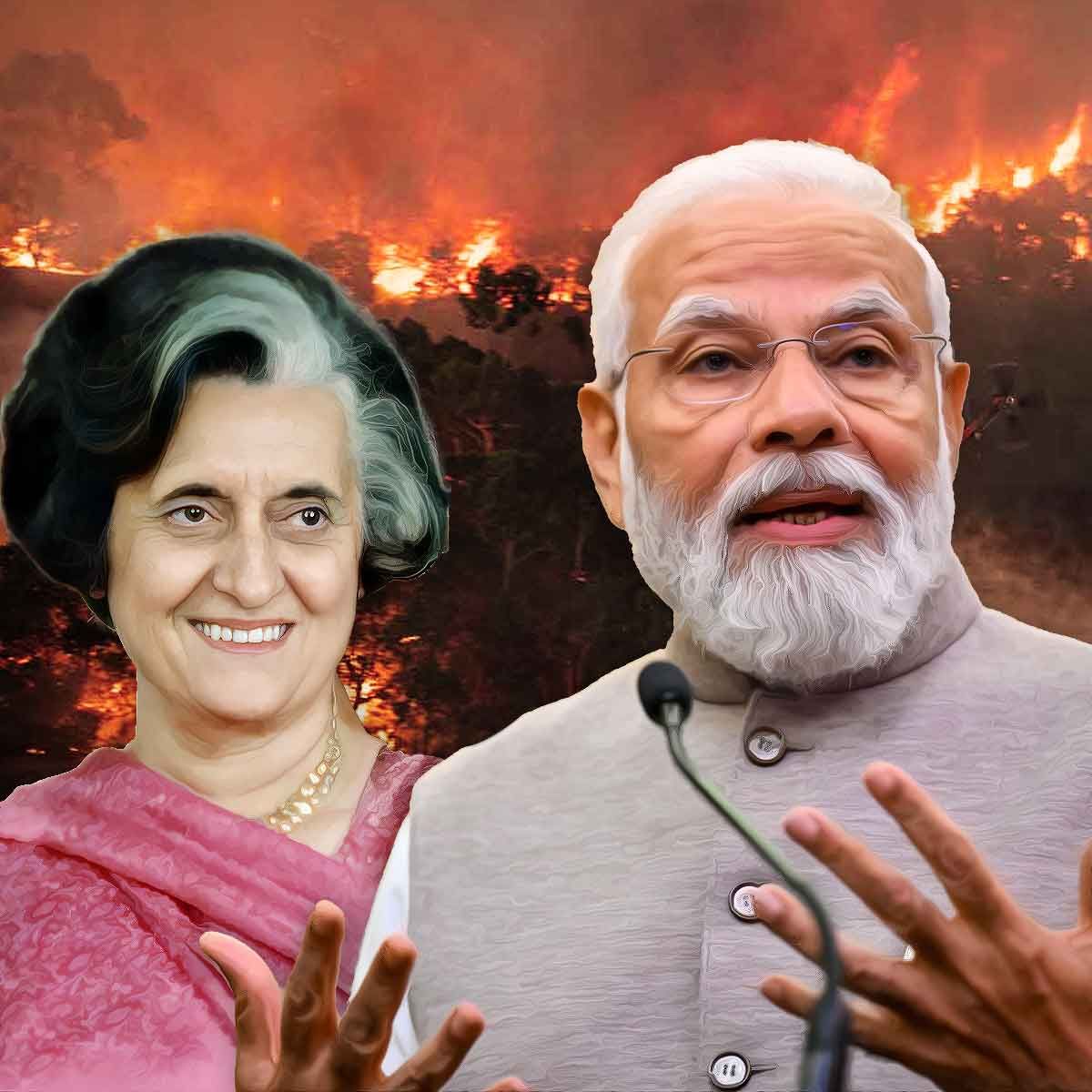Sanatan Articles
Satyaagrah
Written on
Satyaagrah
Written on
Satyaagrah
Written on
Satyaagrah
Written on
Satyaagrah
Written on
JOIN SATYAAGRAH SOCIAL MEDIA
"PM Modi mentions the 1966 bombing of Mizoram": When Indira Gandhi had ordered the IAF to carry out an aerial attack in Aizawl and its aftereffects that still reverberate in India's history, capturing Mizoram's tumultuous journey through adversity

Prime Minister Narendra Modi recently brought up a somber memory from India's past in his address to the Lok Sabha. He recollected the day when the Indian Air Force (IAF) was commanded to launch an aerial assault on Aizawl, Mizoram, in 1966. His exact words were, "On 5th March 1966, the Congress-led government commanded its Air Force to target the defenseless residents of Mizoram. The Congress owes an explanation: Was it the Air Force of some foreign land? Weren't the Mizoram people our own citizens? Shouldn't the Indian Government have been their protector?"
|
Fast-forwarding to August 10, 2023, during a no-confidence motion address in the Lok Sabha, Modi lambasted the then Congress regime, especially Indira Gandhi, for green-lighting such a drastic measure against its own people. The memory of the aerial strike still haunts many, and PM Modi’s remarks have lit a fresh spark, causing ripples and reigniting debates about Mizoram’s turbulent history.
In his poignant speech, he underlined, “The inhabitants of Mizoram continue to grieve over the events of 5th March. Regrettably, there have been scant efforts to heal those wounds. This dark episode, orchestrated by the Congress and primarily under Indira Gandhi's leadership, was kept under wraps for years."
The Infamous Day: March 5, 1966
March 5, without doubt, stands out as a blot on the annals of independent India. While a majority of the populace may be unaware, mainly due to historical omissions by the Congress-led governments, Mizoram's residents have solemnly remembered this day for over half a century, recounting the anguish it brought upon them.
On that fateful day in 1966, IAF jets soared over the skies of what was then known as the Lushai Hills district in Assam. As the engines roared, they released a torrent of incendiary devices, wreaking havoc on numerous settlements below. The order for this heartbreaking move came from the highest echelons of power, specifically from the office of the then Prime Minister, Indira Gandhi.
Casting our minds back, the Mizo National Front (MNF), originally an insurgent group, had a significant role to play in these events. Today, MNF operates within the democratic framework, being a recognized political entity governing Mizoram. But back in the 60s, they held a revolutionary objective. In the dark hours preceding March 1, 1966, they made a bold proclamation of independence from the Indian Union.
Post their declaration, MNF militants coordinated and launched assaults on Indian military and paramilitary bases throughout the Lushai Hills, today's Mizoram. During the early moments of March 1, they struck the district treasury in Aizawl and various police and security stations in places like Lunglei and Champhai, successfully taking control of them. Their aggressive spree continued with an attack on the Assam Rifles' headquarters in Aizawl. Tragically, an ambush soon after on a patrol unit resulted in the demise of five paramilitary personnel.
The Central Government's reaction was swift and marked by anxiety. Nagaland was already grappling with a burgeoning insurgency. Gulzarilal Nanda, the Union Home Minister at the time, sounded alarms, especially upon getting wind of the extensive plans of MNF leader Laldenga.
Laldenga had secretly initiated ties with Pakistan, which, in turn, was clandestinely arming the MNF and providing sanctuaries in East Pakistan, modern-day Bangladesh. This collaboration was of strategic significance, given the Lushai Hills' lengthy border with East Pakistan.
By 1966, the MNF's forces had mushroomed to an impressive eight battalions, bolstered immensely by support from the Pakistani military. They set a daring plan into motion, code-named ‘Operation Jericho’. This strategy involved guerrilla strikes on pivotal government installations and effectively holding high-ranking officials stationed in the Lushai Hills captive.
Their overarching objective? To unfurl the flag of an independent Mizoram in Aizawl and have it wave proudly for two full days, while simultaneously seeking international recognition, with Pakistan leading the charge at the United Nations. As the plan was activated, the situation seemed grim for the besieged Indian forces in Aizawl, raising tensions across the region.
The MNF's Ambitious Plan and the Government's Response
Having neutralized several security installations, the Mizo National Front (MNF) aimed to hoist the flag of an independent Mizoram in Aizawl, allowing it to flutter for two consecutive days. Laldenga, the MNF leader, had already secured an assurance from Pakistan: following the success of their plan, Pakistan, supported by other allies, would champion Mizoram's case in the United Nations, vouching for its recognition as an independent nation. Instantly, Pakistan would formally recognize Mizoram as a sovereign country.
The MNF's audacious plan, partly devised with Pakistan's guidance, commenced with surprise assaults on vital government installations and the Assam Rifles in Aizawl. The jawans of Assam Rifles, although caught off guard, mounted a fierce resistance for three days. Their resources dwindled rapidly, particularly ammunition, leading to urgent calls for reinforcements. By March 4, the beleaguered headquarters seemed destined to fall into MNF's hands, which would have marked the success of 'Operation Jericho.'
In this high-pressure scenario, Home Minister Nanda and Prime Minister Indira Gandhi felt the weight of the crisis. The geography of Lushai Hills and the MNF's dominance over several routes made it impossible to promptly send reinforcements by road. Airdropping troops was also ruled out due to the extensive rebel presence. The situation demanded drastic measures.
Despite the ethical and moral implications, Indira Gandhi chose to use the Indian Air Force's firepower against the MNF strongholds. Between March 5 and 8, IAF jets, primarily Hunters and Toofanis, embarked on sorties from the Kumbhirgram base in Assam, targeting Aizawl and several significant villages. Aizawl bore the brunt of these raids; incendiary bombs decimated houses, schools, churches, and even medical facilities.
Remarkably, the civilian death toll remained low. Anticipating the violence, most of Aizawl's 10,000 inhabitants had already evacuated, seeking refuge in neighboring villages and forests. This precautionary migration ensured that, despite the destructive raids, only 15 civilian lives were lost.
Professor J.V Hluna of Pachhunga University College in Aizawl, also a notable member of the state's BJP unit, shared his first-hand account of those traumatic times. Hluna, a high school student then, had relocated to Zokhawsang village with his family. From there, they witnessed the harrowing bombings: the ear-splitting roars of fighter jets, the sky blackened with smoke, and Aizawl engulfed in flames. It was a heart-wrenching spectacle that left them paralyzed with shock and fear.
Similarly, Zosiami, an octogenarian and erstwhile social worker, painted a haunting picture of those times. She narrated how her family, from their hideout on Lawipu Hill, watched Aizawl suffer under the continuous bombings. The sheer scale of devastation was overwhelming. When Zosiami and her family eventually returned to Aizawl on March 11, they found their home razed to the ground, with not a single belonging salvageable.
The onslaught wasn't limited to Aizawl. Over the subsequent weeks, IAF raids decimated several villages: Khawzawl on March 6, Hnahlan on March 7, Sangau on March 8, Tlabung on March 9, Pukpui on March 13, and Bunghmun on March 23. Moreover, sporadic bombings persisted in other regions well beyond March, leaving a legacy of pain and a region scarred by its own nation's actions.
The Intensified Response and Aftermath
The Indian Air Force (IAF) had adopted an aggressive strategy against the Mizo National Front (MNF) rebels. Professor Hluna asserted that the IAF's deployment was a direct response to any major threat posed by the MNF. Consequently, the villages of Mualthuam, Tuipui (Laldenga's birthplace), and Hmuntlang faced bombings in September 1966 and January 1967.
The Indian government was determined to prevent news of the bombings from spreading, effectively imposing a media blackout on the issue. As a result, the rest of India and the world remained largely uninformed about the events as they unfolded.
However, Denghnuna, an official from the Assam government at the time, noted that it was inevitable for the truth to surface. Eventually, the issue was discussed in the Assam Assembly. A fact-finding team, led by two legislators, Stanley D.D. Nichols Roy and Hoover Hynniewta, along with Lok Sabha MP George Gilbert Swell, embarked on a mission to gather evidence. Their findings corroborated the bombings, revealing the vast devastation, including significant government infrastructure in Aizawl.
Prime Minister Indira Gandhi, however, publicly dismissed the findings, insisting that the IAF had only para-dropped supplies for the trapped Assam Rifles personnel. Swell countered her claim in the Lok Sabha by displaying photographs of the destruction and showcasing remnants of the bombings. Although the revelation caused an uproar, a subdued opposition failed to pressurize the Prime Minister into retracting her statements. Intriguingly, Swell later identified Rajesh Pilot and Suresh Kalmadi as among the IAF pilots responsible for the bombings over Aizawl, a claim endorsed by Denghnuna.
In the aftermath, the Lushai Hills saw a surge in military personnel, further intensifying counter-insurgency operations. The actions that followed were marked by severity. R Zamawia, once an MNF member and later its 'defence minister', detailed the subsequent operations. Villages suspected of MNF sympathies were evacuated, razed, and the inhabitants were relocated along main roads and highways. These settlements, closely monitored by the military, had movement restrictions. Additionally, numerous civilians faced arrest, and many suffered torture or were never seen again.
The bombings, the demolition of villages, the forced resettlements, and the widespread human rights violations have left an indelible mark on the Mizo psyche. Denghnuna emphasized that while physical wounds might have healed over time, the emotional scars remain fresh. He lamented the Indian government's failure to address this trauma.
To commemorate these dark times, the Mizos observe March 5 as "Zoram Ni" (Zoram Day). It's a day marked with prayers across the state, urging the populace to forgive the wrongs done to their ancestors during the two-decade-long insurgency (1966-1986). Denghnuna pointed out that the Mizos are open to forgiveness, but they expect the Indian government to acknowledge its actions and seek reconciliation. An official recognition of the events and subsequent apologies could be a step towards healing.
Genesis of the Mizo Insurgency
The roots of the Mizo insurgency trace back to an environmental and ecological event: the flowering of bamboo plants, which happens every 40-50 years. In 1959, the bamboo plants in the Lushai Hills flowered, attracting rodents. With a rapid multiplication of rodents, they started devouring the food stocks and crops, resulting in a famine named 'mautam' in Mizo.
However, the main contributor to the arising discontent wasn't just the natural calamity but the ill-prepared response from the Assam government. Their inability to provide timely relief and assistance led to widespread starvation and deaths. A social organization, initially named 'Mizo Cultural Society' and having Laldenga as its secretary since 1955, was instrumental in providing aid. Later, this organization transformed its identity to the 'Mautam Front' and then 'Mizo National Famine Front' to directly address the famine.
In a turn of events, by 1961, this group transitioned into the Mizo National Front (MNF). The sentiment of anger and resentment against the state, due to its inadequate response to the famine, had not subsided. The MNF, capitalizing on its reputation, started addressing political concerns. They advocated for the unification of Mizo-inhabited areas from neighboring regions like Manipur, Tripura, and the Cachar Hills of Assam into an integrated administrative entity, seeking statehood for it.
The Assam government's approach to the Mizo demands was dismissive. They ignored calls for greater autonomy under the Constitution's Sixth Schedule. Further aggravating matters, Assamese was enforced as a mandatory first language across Assam, including in the non-Assamese speaking Lushai Hills. Such actions did not sit well with the Mizos, fueling resentment.
What started as a plea for identity and regional autonomy soon transformed into a demand for an independent nation, especially with the backdrop of government neglect during the famine. Laldenga sought external assistance, establishing contact with Pakistan in 1961, which promised financial and logistical support. With its newfound backing, the MNF initiated the recruitment drive for the 'Mizo National Army,' with recruits receiving arms and guerilla warfare training in East Pakistan. By 1966, MNF's strength burgeoned to eight battalions, culminating in 'Operation Jericho' on March 1.
While the Assam government's lack of empathy and indifference played a significant role in the insurgency's rise, the central government under Indira Gandhi, too, bears responsibility, especially for the bombings of Aizawl and subsequent brutalities. The Union Government, along with the army and paramilitary forces, were seemingly unprepared for MNF's surprise attacks, highlighting a glaring intelligence lapse.
Ultimately, the tumultuous chapter of the Mizo insurgency drew to a close in 1986 with the Mizo Peace Accord, facilitated by Rajiv Gandhi. Ironically, Rajiv's involvement in the peace process came two decades after his mother, Indira Gandhi, had authorized aggressive action against the MNF rebels.
The Role of Suresh Kalmadi and Rajesh Pilot in the Bombing of Aizawl
Two prominent figures, Suresh Kalmadi and Rajesh Pilot, have consistently made headlines throughout Indian history. Their purported connection with the Aizawl bombings during the Mizo insurgency has been a subject of heated debate and speculation over the years.
The Mizo National Front (MNF) and the Indian Army were locked in a fierce battle, with the former making significant inroads. The Indian government, led by then Prime Minister Indira Gandhi, faced a dire situation. The controversial step to deploy the Indian Air Force (IAF) to bomb its own city, Aizawl, was a drastic measure that underscored the severity of the situation.
It was later unveiled that among those who piloted the IAF's aircrafts during the Aizawl raids were Suresh Kalmadi and Rajesh Pilot. This revelation has its roots in the accounts of individuals such as Denghnuna, who was closely associated with the Assam government's PR machinery, and George Gilbert Swell, the Shillong Lok Sabha MP of that time.
Both Rajesh Pilot and Suresh Kalmadi moved into the realm of politics post their IAF service. While Pilot held esteemed positions in various governments, Kalmadi made headlines with his involvement in Indian sports, particularly with the Indian Olympic Association. However, the dark shadow of their purported involvement in the Aizawl bombings remained a controversial topic among certain sections of society.
The Mizo insurgency and the subsequent actions taken by the Indian government are pivotal chapters in the nation's history. Amidst this, the alleged involvement of Kalmadi and Pilot in the Aizawl bombings remains a topic of discussion, as it delves into the complexities of governance, duty, and personal choices during times of conflict.
Part 2 - Diving Deep into Internet Details
Before his entry into the political limelight, Suresh Kalmadi donned the uniform, serving as an officer in the Indian Air Force. His political aspirations led him to the Congress party, where he was elected to the Parliament on multiple occasions. However, the peak of his recognition came during his presidency of the Indian Olympic Association (IOA), especially during the 2010 Delhi Commonwealth Games. This period was also marred by allegations of corruption, culminating in his arrest in 2011, though he eventually secured bail.
The moniker "Pilot" wasn't just a surname for Rajeshwar Prasad Singh Bidhuri; it was an homage to his profession in the Indian Air Force. As a stalwart in the Congress party, Rajesh Pilot's political trajectory saw him taking on roles like the Minister of Surface Transport and Internal Security. Beyond his ministerial duties, what endeared him to many was his genuine connection to the grassroots level of society. His name frequently came up as a potent candidate for the Chief Minister position in Rajasthan. His untimely demise in a car accident in 2000 cut short a promising political journey.
In a recent Parliamentary session, Prime Minister Narendra Modi brought to the forefront a somber chapter from 1966. It pertained to a distressing incident where the Indian Air Force was directed to bomb its own land and people in Mizoram. The aftermath was heart-wrenching with 40 innocent lives lost.
This event is unparalleled in Indian history, marking the only time the Indian Air Force turned against its own. The masterminds behind this operation, as per various sources, were fighter pilots Suresh Kalmadi and Rajesh Pilot.
These pilots were briefed on the potential political fallout and assured that, in the face of inevitable public outrage, they would be asked to step down. This sacrifice, however, came with a promise: subsequent induction into the Congress Party with the guarantee of ministerial roles. This blueprint was meticulously executed.
The reverberations of this incident were strongly felt in the Parliament. In an attempt to douse the flames of anger, particularly from the North-East region, the Indian Air Force declared the voluntary resignations of both pilots. Their subsequent covert integration into the Indian National Congress led to them not only becoming influential Central Ministers but also key figures in the Congress party's landscape.
In conclusion, the stories of Kalmadi and Pilot, intertwined with the Aizawl bombings, highlight the intricate mesh of duty, politics, and personal ambitions that play out on the nation's grand stage.
 Support Us
Support Us
Satyagraha was born from the heart of our land, with an undying aim to unveil the true essence of Bharat. It seeks to illuminate the hidden tales of our valiant freedom fighters and the rich chronicles that haven't yet sung their complete melody in the mainstream.
While platforms like NDTV and 'The Wire' effortlessly garner funds under the banner of safeguarding democracy, we at Satyagraha walk a different path. Our strength and resonance come from you. In this journey to weave a stronger Bharat, every little contribution amplifies our voice. Let's come together, contribute as you can, and champion the true spirit of our nation.
 |  |  |
| ICICI Bank of Satyaagrah | Razorpay Bank of Satyaagrah | PayPal Bank of Satyaagrah - For International Payments |
If all above doesn't work, then try the LINK below:
Please share the article on other platforms
DISCLAIMER: The author is solely responsible for the views expressed in this article. The author carries the responsibility for citing and/or licensing of images utilized within the text. The website also frequently uses non-commercial images for representational purposes only in line with the article. We are not responsible for the authenticity of such images. If some images have a copyright issue, we request the person/entity to contact us at This email address is being protected from spambots. You need JavaScript enabled to view it. and we will take the necessary actions to resolve the issue.
Related Articles
- Wikileaks and 5 lesser know facts of Indira Gandhi: Nuclear technology, corruption and foreign relations
- Rajiv Gandhi didn't call Army for 3 days, had no intention to stop 1984 Sikh massacre: Watch his speech justifying the riot
- Biggest Secret Reveal - How ties between Indra Gandhi and KGB made India a puppet of USSR during the Cold War
- How Political ambitions of the Congress has silenced contributions of uncountable freedom fighters
- Saam Daam Dand Bhed: How Indira and Sanjay Gandhi pulled off the Maruti scam
- Retd Commander VK Jaitly admits that he was a witness to Rajiv and Sonia Gandhi using INS Viraat to vacation on Lakshwadeep
- How undisciplined Indira Gandhi when expelled from Congress Party by 'Syndicate', divided the party into two: 12 November 1969
- Rare footage of Pakistan Army surrendering to Indian Armed Forces after the humiliating defeat in 1971 war: Vijay Diwas
- Ghost from the past: Unseen picture of Nehru voting in favour of partition of India goes viral
- Can Communism and Democracy Coexist - 100 Years of Russian Revolution
- Was Indira Gandhi a Soviet Agent - 100 Years of Russian Revolution
- How Communists betrayed India - 100 Years of Russian Revolution
- "Who gifted 163-acre Katchatheevu Island to Sri Lanka as a gift, wasn’t that part of Maa Bharati there," PM Narendra Modi tore Congress while replying at the No-Confidence Motion, highlighting DMK and CM Stalin consistent pleas urging its retrieval
- How Nehru had laid blue print of Indira Gandhi inheriting his PM post
- Indira Gandhi’s bahu published intimate photos of Jagjivan Ram’s son in her magazine: This 'Saas-Bahu ki Saajish' mothered India’s first major political sex scandal which cost Jagjivan his political career





















